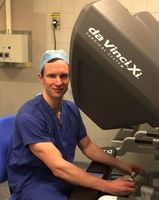Central Auckland, East Auckland, North Auckland, South Auckland, West Auckland > Private Hospitals & Specialists >
OneSixOne
Private Service, Urology, Obstetrics and Gynaecology
Today
Description
One Six One is a Urology and Gynaecology specialist practice
Comprehensive
- 8 Urologists, 6 Gynaecologists, Renal Physician, Dietitian and 2 Physios
- Full-time specialist nursing support including a Urology/UroGynae Nurse Specialist
- Multiple languages supported
Convenient
- Access to short notice appointments for urgent concerns - 30 clinics each week to fit urgent patients in if required
- Consult clinics located across Auckland - North (including Warkworth), South (including Pukekohe), and East
- Renal Colic, Haematuria, Prostate Cancer fast track appointments, streamlined care pathways developed in conjunction with Mercy Radiology for required tests
- Day Stay surgical facility onsite for quick and convenient access to minor procedures
Multi-disciplinary, wrap around care:
- Consultant collaboration possible due to wide range and large number of specialists in one place
- Unique ability for consultants to subspecialise - patients can be transferred to in-house experts
- Coordination and collaboration with other organisations - enabling streamlined wrap-around care for patients, particularly pre and post surgery
- Private multi-disciplinary team meetings
Day-stay facility
- The recently renovated facility at 161 Gillies Ave, Epsom, has five consulting rooms, two minor procedure rooms, and a day-stay theatre
* We are accredited to NZS 8164:2005 Day-Stay Surgery and Procedure standards *
Areas of specialty at OneSixOne include:
- Urologic Oncology (including prostate, kidney, bladder, testicular cancer)
- Female Urology (urinary incontinence, pelvic outlet relaxation disorders)
- Robotic and minimally invasive surgery
- Kidney stones (urinary tract stones)
- Men's urinary symptoms (BPH) including: comprehensive assessment and REZUM, TURP, Laser
- Neurourology (voiding disorders, urodynamic evaluation of patients and erectile dysfunction or impotence)
- Circumcisions, Vasectomies (and reversal)
- Men's Health Clinic including erectile dysfunction
- Bladder instillation treatment including BCG (for Bladder Cancer)
- Incontinence Issues
- Female surgical mesh complications
- Prostate cancer symptoms
- Urinary tract infections
- Renal transplantation
- Male infertility
Some procedures performed at the OneSixOne day-stay facility include:
- Transperineal Biopsy
- Flexible Cystoscopy
- Trus Biopsy
- TURBT
- REZUM
- Urolift
- Urodynamics
- BCG Treatment for Bladder Cancer
- Circumcision
- Vasectomy
- Hysteroscopy
- Colposcopy
- Ureteroscopy
Consultants
-

Dr Ngaire Anderson
Gynaecologist
-

Mr Tony Beaven
Urologist
-

Dr Fiona Connell
Gynaecologist
-

Mr Jason Du
Urologist
-

Dr Nicola Dykes
Gynaecologist
-

Dr Eva Fong
Urologist
-

Mr Madhu Koya
Urologist
-

Dr Padmaja Koya
Gynaecologist
-

Mr Andrew Lienert
Urologist
-
Dr Sum Sum Lo
Urogynaecologist
-

Dr Jye Lu
Gynaecologist
-

Dr Jasmine Tan
Endocrinologist
-

Dr Louise Tomlinson
Gynaecologist
-

Mr Simon van Rij
Urologist
-

Dr Andrew Williams
Urologist
Referral Expectations
GP or specialist referral is preferred, however we do also welcome direct enquiries.
Please bring any documentation you may have, for instance:
- a referral letter from your GP
- any scans, x-rays, or blood results
- a list of your current medications and dosages.
N.B. If you are self referred then clearly you won't have a GP's letter, however any information you are able to provide that will assist in a diagnosis will be most helpful.
If this is your first consultation you won't be required to fast, although if you have been asked to have a flow-test on arrival, then arriving with a full bladder is most helpful.
Please click here to access other forms and instructions.
Fees and Charges Description
OneSixOne Medical Group Ltd is a Southern Cross Affiliated provider for the following procedures at our day-stay facility
- Transperineal prostate biopsy
- Circumcision
- Transurethral resection of bladder tumour
- Ureteroscopy
- BCG Treatment for Bladder Cancer (Bacillus Calmette-Guerin Immunotherapy)
Our consultants also have Affiliated Provider contracts with Southern Cross for a wide range of services
Hours
| Mon – Fri | 8:00 AM – 5:00 PM |
|---|
Please contact the practice during business hours, Monday to Friday, to arrange appointments.
Public Holidays: Closed ANZAC Day (25 Apr), King's Birthday (3 Jun), Matariki (28 Jun), Labour Day (28 Oct), Auckland Anniversary (27 Jan), Waitangi Day (6 Feb), Good Friday (18 Apr), Easter Sunday (20 Apr), Easter Monday (21 Apr).
Languages Spoken
Bahasa Melayu, Mandarin Chinese, English
Procedures / Treatments
Urinalysis is a test that examines the content of urine for abnormal substances such as protein or signs of infection. This test involves urinating into a special container and leaving the sample to be studied.
Urinalysis is a test that examines the content of urine for abnormal substances such as protein or signs of infection. This test involves urinating into a special container and leaving the sample to be studied.
Urodynamic tests measure the storage of urine in the bladder and the flow of urine from the bladder through the urethra. Your doctor may want to do an urodynamic test if you are having symptoms that suggest problems with the muscles or nerves of your lower urinary system and pelvis.
Urodynamic tests measure the storage of urine in the bladder and the flow of urine from the bladder through the urethra. Your doctor may want to do an urodynamic test if you are having symptoms that suggest problems with the muscles or nerves of your lower urinary system and pelvis.
This term means protein in the urine and may indicate that there is a problem with your kidneys.
This term means protein in the urine and may indicate that there is a problem with your kidneys.
This term means blood in the urine and may be the result of inflammation or other problems with your kidneys, blockages in your ureter, infection or other problems with your bladder or problems with your prostate.
This term means blood in the urine and may be the result of inflammation or other problems with your kidneys, blockages in your ureter, infection or other problems with your bladder or problems with your prostate.
A UTI is caused by an infection in the urinary tract. Women get UTIs more often than men. UTIs are treated with antibiotics. Drinking lots of water also helps by flushing out the bacteria. If the infection is in the bladder it is called cystitis. If the infection is in the kidneys it is called pyelonephritis.
A UTI is caused by an infection in the urinary tract. Women get UTIs more often than men. UTIs are treated with antibiotics. Drinking lots of water also helps by flushing out the bacteria. If the infection is in the bladder it is called cystitis. If the infection is in the kidneys it is called pyelonephritis.
Urinary incontinence or loss of bladder control is the involuntary passage of urine (passing urine without meaning to). There are many causes and types of incontinence, and many treatment options. Treatments range from simple exercises to surgery. Women are affected by urinary incontinence more often than men.
Urinary incontinence or loss of bladder control is the involuntary passage of urine (passing urine without meaning to). There are many causes and types of incontinence, and many treatment options. Treatments range from simple exercises to surgery. Women are affected by urinary incontinence more often than men.
Urinary retention, or abnormal holding of urine in the bladder, is a common urological problem. Possible causes of acute urinary retention (sudden inability to urinate) include a blockage in the urinary system, stress or nerve problems. Chronic urinary retention (some urine is always left in the bladder after emptying) may be caused by bladder muscle failure, nerve damage, or obstructions in the urinary tract. Treatment for urinary retention depends on the cause.
Urinary retention, or abnormal holding of urine in the bladder, is a common urological problem. Possible causes of acute urinary retention (sudden inability to urinate) include a blockage in the urinary system, stress or nerve problems. Chronic urinary retention (some urine is always left in the bladder after emptying) may be caused by bladder muscle failure, nerve damage, or obstructions in the urinary tract. Treatment for urinary retention depends on the cause.
What causes bladder cancer is not always clear, but the risk of developing bladder cancer can be increased by smoking, getting older, long term bladder problems and unsafe exposure to aniline dyes which are used in some industries. Bladder tumours usually form in cells lining the bladder. Once a tumour begins to enlarge, it may stay in the lining or grow into the wall of the bladder. If untreated, the tumour may then grow into other structures such as lymph nodes. If the cancer enters the bloodstream it may spread to other areas of the body (metastasis). Often the first symptom noticed is blood in the urine, other symptoms such as needing to pass urine more often or feeling as if you need to go but can’t affect about 1/3 of people with early bladder cancer. As the tumour grows these symptoms affect more people. The first test to diagnose bladder cancer is usually a urine sample. Sometimes a tube will be inserted through the urethra and the bladder will be washed with liquid to try to wash out some cancer cells for diagnosis. If cancer is suspected, the next step is usually a cytoscopy (a tube to allow the doctor to look inside the bladder). If there is to be a tumour the doctor can take a small sample (biopsy) for testing. CT or MRI scans are also used to scan the body to see if the cancer has spread to other areas. Treatment depends on the size of the tumour and how much it has grown into the bladder wall. Surgery may be considered especially if the tumour is still small. The surgeon can insert a cytoscope through the urethra and cut out the tumour or burn it away. If the tumour has grown more deeply the surgeon may cut open the abdomen and remove some or the entire bladder (a partial or full cystectomy). If the whole bladder is removed an artificial bladder will be created on the inside or a urostomy bag on the outside. Radiotherapy (an x-ray beam) can be used as the main treatment in some people and in others may be used after surgery to remove any remaining cancer cells. In early cancer, drugs (chemotherapy) or another treatment called BCG may be placed directly into the bladder to kill cancer cells (intravesical treatment). Usually though, chemotherapy is used in the later stages where it can attack cancer cells throughout the body (not just the bladder) and help stop the cancer spreading.
What causes bladder cancer is not always clear, but the risk of developing bladder cancer can be increased by smoking, getting older, long term bladder problems and unsafe exposure to aniline dyes which are used in some industries. Bladder tumours usually form in cells lining the bladder. Once a tumour begins to enlarge, it may stay in the lining or grow into the wall of the bladder. If untreated, the tumour may then grow into other structures such as lymph nodes. If the cancer enters the bloodstream it may spread to other areas of the body (metastasis). Often the first symptom noticed is blood in the urine, other symptoms such as needing to pass urine more often or feeling as if you need to go but can’t affect about 1/3 of people with early bladder cancer. As the tumour grows these symptoms affect more people. The first test to diagnose bladder cancer is usually a urine sample. Sometimes a tube will be inserted through the urethra and the bladder will be washed with liquid to try to wash out some cancer cells for diagnosis. If cancer is suspected, the next step is usually a cytoscopy (a tube to allow the doctor to look inside the bladder). If there is to be a tumour the doctor can take a small sample (biopsy) for testing. CT or MRI scans are also used to scan the body to see if the cancer has spread to other areas. Treatment depends on the size of the tumour and how much it has grown into the bladder wall. Surgery may be considered especially if the tumour is still small. The surgeon can insert a cytoscope through the urethra and cut out the tumour or burn it away. If the tumour has grown more deeply the surgeon may cut open the abdomen and remove some or the entire bladder (a partial or full cystectomy). If the whole bladder is removed an artificial bladder will be created on the inside or a urostomy bag on the outside. Radiotherapy (an x-ray beam) can be used as the main treatment in some people and in others may be used after surgery to remove any remaining cancer cells. In early cancer, drugs (chemotherapy) or another treatment called BCG may be placed directly into the bladder to kill cancer cells (intravesical treatment). Usually though, chemotherapy is used in the later stages where it can attack cancer cells throughout the body (not just the bladder) and help stop the cancer spreading.
This term refers to stones in the urinary system. They form in the kidneys but can be found anywhere in the urinary system. They vary in size and the amount of pain they cause. Many of these stones can pass though without help but some require medical intervention. Extracorporeal shockwave lithotripsy (ESWL) is the most frequently used procedure for the treatment of kidney stones. In ESWL, shock waves that are created outside the body travel through the skin and body tissues until they hit the denser stones. The stones break down into very small particles and are easily passed through the urinary tract in the urine.
This term refers to stones in the urinary system. They form in the kidneys but can be found anywhere in the urinary system. They vary in size and the amount of pain they cause. Many of these stones can pass though without help but some require medical intervention. Extracorporeal shockwave lithotripsy (ESWL) is the most frequently used procedure for the treatment of kidney stones. In ESWL, shock waves that are created outside the body travel through the skin and body tissues until they hit the denser stones. The stones break down into very small particles and are easily passed through the urinary tract in the urine.
Kidney failure occurs when the kidneys cannot remove waste products from the blood or control the amount of water in your body. Acute kidney failure occurs suddenly and may be the result of injury, loss of large amounts of blood, drugs or poisons. Kidneys may return to normal function if they are not too badly damaged. Chronic renal failure means a slow decline in kidney function, which may not be noticed immediately. If renal function continues to deteriorate dialysis may be needed.
Kidney failure occurs when the kidneys cannot remove waste products from the blood or control the amount of water in your body. Acute kidney failure occurs suddenly and may be the result of injury, loss of large amounts of blood, drugs or poisons. Kidneys may return to normal function if they are not too badly damaged. Chronic renal failure means a slow decline in kidney function, which may not be noticed immediately. If renal function continues to deteriorate dialysis may be needed.
This is an enlargement of the prostate gland. In BPH there may be difficulties in passing urine as the enlarged prostate can cause a blockage. Patients with BPH often notice an increased urge to empty the bladder, especially at night. Many men over 60 years of age have some BPH. There are many different treatment options available for people with BPH. Most commonly your doctor can prescribe tablets to improve urinary function.
This is an enlargement of the prostate gland. In BPH there may be difficulties in passing urine as the enlarged prostate can cause a blockage. Patients with BPH often notice an increased urge to empty the bladder, especially at night. Many men over 60 years of age have some BPH. There are many different treatment options available for people with BPH. Most commonly your doctor can prescribe tablets to improve urinary function.
This is the term used to describe inflammation of the prostate gland. Symptoms can include increased need to pass urine and pain on passing urine as well as perhaps lower back pain. Sometimes this inflammation is due to an infection and an antibiotic will be prescribed, otherwise pain relief medication may be prescribed.
This is the term used to describe inflammation of the prostate gland. Symptoms can include increased need to pass urine and pain on passing urine as well as perhaps lower back pain. Sometimes this inflammation is due to an infection and an antibiotic will be prescribed, otherwise pain relief medication may be prescribed.
Prostate cancer typically consists of many very small, tumours within the prostate. At this stage, the disease is often curable (rates of 90% or better) with standard treatments such as surgery or radiation. Unfortunately, at this stage the cancer produces few or no symptoms and can be difficult to detect. If untreated and allowed to grow, the cells from these tumours can spread to other parts of the body in a process called metastasis. Once the cancer has spread beyond the prostate, cure rates drop dramatically. In most cases, prostate cancer is a relatively slow-growing cancer, which means that it typically takes a number of years for the disease to become detectable, and even longer to spread beyond the prostate. However, a small percentage of patients experience more aggressive forms of prostate cancer. Treatments options for prostate cancer include surgery, radiation, hormone treatment and chemotherapy. Which treatment is chosen depends on factors such as the stage of the cancer and the patient’s age, other health issues and willingness to undergo certain procedures or therapies – some of which may have side effects.
Prostate cancer typically consists of many very small, tumours within the prostate. At this stage, the disease is often curable (rates of 90% or better) with standard treatments such as surgery or radiation. Unfortunately, at this stage the cancer produces few or no symptoms and can be difficult to detect. If untreated and allowed to grow, the cells from these tumours can spread to other parts of the body in a process called metastasis. Once the cancer has spread beyond the prostate, cure rates drop dramatically. In most cases, prostate cancer is a relatively slow-growing cancer, which means that it typically takes a number of years for the disease to become detectable, and even longer to spread beyond the prostate. However, a small percentage of patients experience more aggressive forms of prostate cancer. Treatments options for prostate cancer include surgery, radiation, hormone treatment and chemotherapy. Which treatment is chosen depends on factors such as the stage of the cancer and the patient’s age, other health issues and willingness to undergo certain procedures or therapies – some of which may have side effects.
A vasectomy is a minor surgical procedure carried out to make a man sterile (he is no longer able to father a child). It is a commonly used form ofcontraception. A tiny incision (cut) is made in the scrotum and a short length of the vas deferens (the tube carrying sperm away from the testicles where it is produced) is removed and the cut ends sealed.
A vasectomy is a minor surgical procedure carried out to make a man sterile (he is no longer able to father a child). It is a commonly used form ofcontraception. A tiny incision (cut) is made in the scrotum and a short length of the vas deferens (the tube carrying sperm away from the testicles where it is produced) is removed and the cut ends sealed.
A long, thin tube with a tiny camera attached (cystoscope) is inserted into the urinary opening and through the urethra (the tube that carries urine from your bladder to the outside of your body) to your bladder. This allows the urologist to view any abnormalities in your lower urinary tract and, if necessary, take a small tissue sample to look at under the microscope (biopsy).
A long, thin tube with a tiny camera attached (cystoscope) is inserted into the urinary opening and through the urethra (the tube that carries urine from your bladder to the outside of your body) to your bladder. This allows the urologist to view any abnormalities in your lower urinary tract and, if necessary, take a small tissue sample to look at under the microscope (biopsy).
A long, thin tube with a tiny camera attached (cystoscope) is inserted into the urinary opening and through the urethra (the tube that carries urine from your bladder to the outside of your body) to your bladder. This allows the urologist to view any abnormalities in your lower urinary tract and, if necessary, take a small tissue sample to look at under the microscope (biopsy).
Sling procedures are common surgical operations to stop stress incontinence. This is a condition where urine leaks out when movements, such as coughing, laughing or sneezing put pressure on the bladder. Stress incontinence occurs when the muscles supporting the urethra (tube that carries the urine out of the body) become weak and the urethra no longer works well as a valve to keep the urine in the bladder. Sometimes this results from the effects of childbirth. Sling procedures provide support to the weakened muscles by placing a stitch or strip of mesh under the urethra so that it won’t accidentally release urine when there is pressure on the bladder. Burch Procedure In the Burch procedure, permanent stitches are placed on both sides of the urethra to give it more support. The Burch procedure is done under a general anaesthetic (you sleep throughout the procedure) and can be performed by laparoscopic surgery. Tension-Free Vaginal Tape (TVT) Procedure In tension-free vaginal tape (TVT) surgery, a mesh-like tape is placed under the urethra to give it support. The TVT procedure is done through a small cut in the vagina and it is usually performed under local anaesthetic (this means that you don’t have to go to sleep during the operation).
Sling procedures are common surgical operations to stop stress incontinence. This is a condition where urine leaks out when movements, such as coughing, laughing or sneezing put pressure on the bladder. Stress incontinence occurs when the muscles supporting the urethra (tube that carries the urine out of the body) become weak and the urethra no longer works well as a valve to keep the urine in the bladder. Sometimes this results from the effects of childbirth. Sling procedures provide support to the weakened muscles by placing a stitch or strip of mesh under the urethra so that it won’t accidentally release urine when there is pressure on the bladder. Burch Procedure In the Burch procedure, permanent stitches are placed on both sides of the urethra to give it more support. The Burch procedure is done under a general anaesthetic (you sleep throughout the procedure) and can be performed by laparoscopic surgery. Tension-Free Vaginal Tape (TVT) Procedure In tension-free vaginal tape (TVT) surgery, a mesh-like tape is placed under the urethra to give it support. The TVT procedure is done through a small cut in the vagina and it is usually performed under local anaesthetic (this means that you don’t have to go to sleep during the operation).
Sling procedures are common surgical operations to stop stress incontinence. This is a condition where urine leaks out when movements, such as coughing, laughing or sneezing put pressure on the bladder. Stress incontinence occurs when the muscles supporting the urethra (tube that carries the urine out of the body) become weak and the urethra no longer works well as a valve to keep the urine in the bladder. Sometimes this results from the effects of childbirth. Sling procedures provide support to the weakened muscles by placing a stitch or strip of mesh under the urethra so that it won’t accidentally release urine when there is pressure on the bladder.
Burch Procedure
In the Burch procedure, permanent stitches are placed on both sides of the urethra to give it more support. The Burch procedure is done under a general anaesthetic (you sleep throughout the procedure) and can be performed by laparoscopic surgery.
Tension-Free Vaginal Tape (TVT) Procedure
In tension-free vaginal tape (TVT) surgery, a mesh-like tape is placed under the urethra to give it support. The TVT procedure is done through a small cut in the vagina and it is usually performed under local anaesthetic (this means that you don’t have to go to sleep during the operation).
If the uterus (womb) or bladder slips out of position, this is referred to as a prolapse. It is caused when the supporting muscles become weak, allowing a part of the uterus or bladder to bulge into the vagina. The most common reason that these muscles become weak is childbirth, and a uterine prolapse or bladder prolapse (also called cystocoele) is more common in women who have had a lot of babies. Symptoms include pain, heaviness in the vaginal area and a frequent need to pass urine. In mild cases, exercises may help improve the symptoms, but women with more severe prolapses may need to have surgery.
If the uterus (womb) or bladder slips out of position, this is referred to as a prolapse. It is caused when the supporting muscles become weak, allowing a part of the uterus or bladder to bulge into the vagina. The most common reason that these muscles become weak is childbirth, and a uterine prolapse or bladder prolapse (also called cystocoele) is more common in women who have had a lot of babies. Symptoms include pain, heaviness in the vaginal area and a frequent need to pass urine. In mild cases, exercises may help improve the symptoms, but women with more severe prolapses may need to have surgery.
If the uterus (womb) or bladder slips out of position, this is referred to as a prolapse. It is caused when the supporting muscles become weak, allowing a part of the uterus or bladder to bulge into the vagina. The most common reason that these muscles become weak is childbirth, and a uterine prolapse or bladder prolapse (also called cystocoele) is more common in women who have had a lot of babies. Symptoms include pain, heaviness in the vaginal area and a frequent need to pass urine. In mild cases, exercises may help improve the symptoms, but women with more severe prolapses may need to have surgery.
Prostate cancer can be treated with localised radiotherapy by implanting small radioactive seeds into the prostate gland. The seeds are implanted using needles inserted through the perineum (the area between the scrotum and anus) while under spinal or general anaesthetic. Discharge from hospital is usually within 24 hours and normal activities can probably be resumed within 2 or 3 days.
Prostate cancer can be treated with localised radiotherapy by implanting small radioactive seeds into the prostate gland. The seeds are implanted using needles inserted through the perineum (the area between the scrotum and anus) while under spinal or general anaesthetic. Discharge from hospital is usually within 24 hours and normal activities can probably be resumed within 2 or 3 days.
Prostate cancer can be treated with localised radiotherapy by implanting small radioactive seeds into the prostate gland.
The seeds are implanted using needles inserted through the perineum (the area between the scrotum and anus) while under spinal or general anaesthetic.
Discharge from hospital is usually within 24 hours and normal activities can probably be resumed within 2 or 3 days.
A long, thin tube with a tiny camera attached (resectoscope) is inserted into the urinary opening of the penis and through the urethra (the tube that carries urine from your bladder to the outside of your body) to your bladder. The urologist is then able to view the prostate gland and, by passing an instrument through the resectoscope, is able to remove the part of the gland that has become enlarged.
A long, thin tube with a tiny camera attached (resectoscope) is inserted into the urinary opening of the penis and through the urethra (the tube that carries urine from your bladder to the outside of your body) to your bladder. The urologist is then able to view the prostate gland and, by passing an instrument through the resectoscope, is able to remove the part of the gland that has become enlarged.
A long, thin tube with a tiny camera attached (resectoscope) is inserted into the urinary opening of the penis and through the urethra (the tube that carries urine from your bladder to the outside of your body) to your bladder. The urologist is then able to view the prostate gland and, by passing an instrument through the resectoscope, is able to remove the part of the gland that has become enlarged.
This test is a needle biopsy to look for cancer cells in the prostate. Your doctor puts a needle into the prostate through the perineum, which is the skin behind the testicles. They take a number of samples, which are sent to the lab to be looked at under a microscope.
This test is a needle biopsy to look for cancer cells in the prostate. Your doctor puts a needle into the prostate through the perineum, which is the skin behind the testicles. They take a number of samples, which are sent to the lab to be looked at under a microscope.
This test is a needle biopsy to look for cancer cells in the prostate. Your doctor puts a needle into the prostate through the perineum, which is the skin behind the testicles. They take a number of samples, which are sent to the lab to be looked at under a microscope.
A colposcopy is a detailed examination of the cervix (entrance to the uterus) with a specially lit microscope (colposcope). As with a Pap smear, an instrument called a speculum is inserted into the vagina, and then the colposcope is inserted with its light directed on the cervix. A specialist will perform a colposcopy if your Pap smear has shown abnormal or cancerous cells on the cervix. During the colposcopy further samples of tissue (biopsies) are usually removed and examined in the laboratory so the doctor can get a clearer idea of the extent of the abnormal cells.
A colposcopy is a detailed examination of the cervix (entrance to the uterus) with a specially lit microscope (colposcope). As with a Pap smear, an instrument called a speculum is inserted into the vagina, and then the colposcope is inserted with its light directed on the cervix. A specialist will perform a colposcopy if your Pap smear has shown abnormal or cancerous cells on the cervix. During the colposcopy further samples of tissue (biopsies) are usually removed and examined in the laboratory so the doctor can get a clearer idea of the extent of the abnormal cells.
A colposcopy is a detailed examination of the cervix (entrance to the uterus) with a specially lit microscope (colposcope). As with a Pap smear, an instrument called a speculum is inserted into the vagina, and then the colposcope is inserted with its light directed on the cervix. A specialist will perform a colposcopy if your Pap smear has shown abnormal or cancerous cells on the cervix. During the colposcopy further samples of tissue (biopsies) are usually removed and examined in the laboratory so the doctor can get a clearer idea of the extent of the abnormal cells.
Disability Assistance
Wheelchair access, Mobility parking space
Refreshments
Tea, coffee are provided on request, and filtered water is provided for patients in the waiting room.
Public Transport
The Auckland Transport website is a good resource to plan your public transport options.
Parking
Free parking is provided at the front of the practice.
Website
Contact Details
161 Gillies Avenue, Auckland
Central Auckland
-
Phone
(09) 623 0161
-
Fax
(09) 623 4161
Healthlink EDI
tk161uro
Email
Website
161 Gillies Avenue
Epsom
Auckland 1023
Street Address
161 Gillies Avenue
Epsom
Auckland 1023
Postal Address
PO Box 26 498
Epsom
Auckland 1344
Was this page helpful?
This page was last updated at 2:12PM on April 17, 2024. This information is reviewed and edited by OneSixOne.

